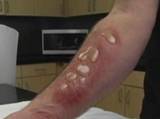|
This page requires
Adobe Flash Player 9.0 (or higher). |
||
|
|
||
|
Burns
·
Look for blistering, sloughing, or charred (blackened) skin. ·
Mild burns with reddened skin and no blisters may be treated with a topical burn
ointment or spray to reduce pain. · Over the counter pain relievers like ibuprofen or acetaminophen can be used for the pain of a mild burn (typically redness only). If stronger pain relief is needed, contact a physician or go to the emergency department. Types of BurnsBurns are classified as first, second or third degree burns depending on the amount and depth of tissue damage. First-Degree BurnA first-degree burn causes damage to the epidermis, causing pain, redness and some swelling. Typically, this type of burn will heal without scarring. Second-Degree BurnA second-degree burn causes damage to the epidermis and the dermis, and this burn usually results in pain, redness and blistering. Third-Degree BurnThird degree burns are
the most severe because the damage extends past the upper layers of skin to the
sensitive subcutaneous tissue, destroying nerves, blood vessels, and other
dermal components. If the skin is unbroken, run cool water over the area of the burn or soak it in a cool water bath (not ice water). Keep the area submerged for at least 5 minutes. A clean, cold, wet towel will also help reduce pain. Calm and reassure the person. After flushing or soaking, cover the burn with a dry, sterile bandage or clean dressing. Protect the burn from pressure and friction. Over-the-counter ibuprofen or acetaminophen can help relieve pain and swelling. Do NOT give children under 12 aspirin. Once the skin has cooled, moisturizing lotion also can help. Minor burns will usually heal without further treatment. However, if a second-degree burn covers an area more than 2 to 3 inches in diameter, or if it is located on the hands, feet, face, groin, buttocks, or a major joint, treat the burn as a major burn. Make sure the person is up to date on tetanus immunization. FOR MAJOR BURNS If someone is on fire, tell the person to stop, drop, and roll. Wrap the person in thick material to smother the flames (a wool or cotton coat, rug, or blanket). Douse the person with water. Call an ambulance. Make sure that the person is no longer in contact with smouldering materials. However, do NOT remove burned clothing that is stuck to the skin. Make sure the person is breathing. If breathing has stopped, or if the person's airways are blocked, open the airways. If necessary, begin rescue breathing and CPR. Cover the burn area with a dry sterile bandage (if available) or clean cloth. A sheet will do if the burned area is large. Do NOT apply any ointments. Avoid breaking burn blisters. If fingers or toes have been burned, separate them with dry, sterile, non-adhesive dressings. Elevate the body part that is burned above the level of the heart. Protect the burn area from pressure and friction. Take steps to prevent shock. Lay the person flat, elevate the feet about 12 inches, and cover the person with a coat or blanket. However, do NOT place the person in this shock position if a head, neck, back, or leg injury is suspected or if it makes the person uncomfortable. Continue to monitor the person's vital signs until medical help arrives. This means pulse, rate of breathing, and blood pressure. DO NOT
|
||
|
|
||
 ·
·